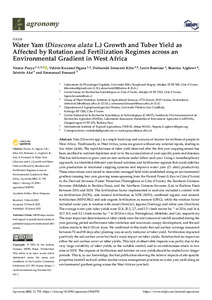| dc.contributor.author | Pouya, N. |
| dc.contributor.author | Hgaza, V.K. |
| dc.contributor.author | Kiba, D.I. |
| dc.contributor.author | Bomisso, L. |
| dc.contributor.author | Aighewi, B. |
| dc.contributor.author | Ake, S. |
| dc.contributor.author | Frossard, E. |
| dc.date.accessioned | 2022-05-19T14:40:42Z |
| dc.date.available | 2022-05-19T14:40:42Z |
| dc.date.issued | 2022 |
| dc.identifier.citation | Pouya, N., Hgaza, V.K., Kiba, D.I., Bomisso, L., Aighewi, B., Aké, S. & Frossard, E. (2022). Water yam (Dioscorea alata L.) growth and tuber yield as affected by rotation and fertilization regimes across an environmental gradient in west Africa. Agronomy, 12(4), 1-22. |
| dc.identifier.issn | 2073-4395 |
| dc.identifier.uri | https://hdl.handle.net/20.500.12478/7469 |
| dc.description.abstract | Yam (Dioscorea spp.) is a staple food crop and a source of income for millions of people in West Africa. Traditionally, in West Africa, yams are grown without any external inputs, leading to low tuber yields. The rapid decrease of tuber yield observed after the first yam cropping season has been ascribed to nutrient depletion and/or to the accumulation of yam-specific pests and diseases. This has led farmers to grow yam on new surfaces under fallow each year. Using a transdisciplinary approach, we identified different yam-based rotations and fertilization regimes that could stabilize yam production in rotational cropping systems and improve water yam (D. alata) productivity. These innovations were tested in researcher-managed field trials established along an environmental gradient crossing four yam growing zones spanning from the Humid Forest (Liliyo in Côte d’Ivoire) to the Derived Savanna/Forest Transition (Tiéningboué in Côte d’Ivoire), the Southern Guinean Savanna (Midebdo in Burkina Faso), and the Northern Guinean Savanna (Léo in Burkina Faso) between 2016 and 2018. The fertilization factor implemented at each site included a control with no fertilization (NON), sole mineral fertilization as NPK (MIN), combined organic and mineral fertilization (MINORG) and sole organic fertilization as manure (ORG), while the rotation factor included water yam in rotation with cereal (YamCer), legume (YamLeg), and white yam (YamYam). The average water yam tuber yields were 32.8, 20.3, 2.7, and 2.5 t fresh matter ha−1 in 2016, and 16.4, 10.7, 8.9, and 5.2 t fresh matter ha−1 in 2018 in Liliyo, Tiéningboué, Midebdo, and Léo, respectively. The most important determinants of tuber yields were the total amount of rainfall recorded during the yam growing period and between tuber initiation and maximum canopy development, and the soil carbon stocks in the 0–30-cm layer. We confirmed in this study that soil surface coverage measured between 70 and 98 days after planting was an early indicator of tuber yield. Fertilization impacted positively the soil surface cover but had a weak impact on tuber yields. Rotation had no impact on either the soil surface cover or tuber yields. This lack of observable impacts was partly due to the very large variability of tuber yields, to the variable rainfall, and to an anthracnose attack in two sites in 2018. The impacts of fertilization and rotation on yam yields should be studied over longer periods. This is, to our knowledge, the first publication showing the relative impacts of site-specific properties (rainfall and soil carbon stocks) versus management practices on water yam yield along an environmental gradient going across the West African yam belt. |
| dc.description.sponsorship | Swiss Program for Research on Global Issues for Development |
| dc.format.extent | 1-22 |
| dc.language.iso | en |
| dc.subject | Soil |
| dc.subject | Rain |
| dc.subject | Yams |
| dc.subject | Yields |
| dc.subject | Dioscorea Alata |
| dc.subject | West Africa |
| dc.title | Water yam (Dioscorea alata L.) growth and tuber yield as affected by rotation and fertilization regimes across an environmental gradient in west Africa |
| dc.type | Journal Article |
| cg.contributor.crp | Roots, Tubers and Bananas |
| cg.contributor.affiliation | Université Félix Houphouët Boigny |
| cg.contributor.affiliation | Centre Suisse de Recherches Scientifiques en Côte d’Ivoire |
| cg.contributor.affiliation | Institute of Agricultural Sciences, Switzerland |
| cg.contributor.affiliation | Université Peleforo Gon Coulibaly |
| cg.contributor.affiliation | Centre National de la Recherche Scientifique et Technologique, Burkina Faso |
| cg.contributor.affiliation | International Institute of Tropical Agriculture |
| cg.coverage.region | Africa |
| cg.coverage.region | West Africa |
| cg.coverage.country | Burkina Faso (Upper Volta) |
| cg.coverage.country | Cote d’Ivoire (Ivory Coast) |
| cg.coverage.hub | Headquarters and Western Africa Hub |
| cg.researchtheme | Plant Production and Health |
| cg.identifier.bibtexciteid | POUYA:2022 |
| cg.isijournal | ISI Journal |
| cg.authorship.types | CGIAR and developing country institute |
| cg.iitasubject | Agronomy |
| cg.iitasubject | Food Security |
| cg.iitasubject | Plant Breeding |
| cg.iitasubject | Plant Production |
| cg.iitasubject | Soil Fertility |
| cg.iitasubject | Yam |
| cg.journal | Agronomy |
| cg.notes | Open Access Journal; Published online: 25 Mar 2022 |
| cg.accessibilitystatus | Open Access |
| cg.reviewstatus | Peer Review |
| cg.usagerightslicense | Creative Commons Attribution 4.0 (CC BY 0.0) |
| cg.targetaudience | Scientists |
| cg.identifier.doi | https://dx.doi.org/10.3390/agronomy12040792 |
| cg.iitaauthor.identifier | Beatrice Aighewi: 0000-0002-9398-1674 |
| cg.futureupdate.required | No |
| cg.identifier.issue | 4 |
| cg.identifier.volume | 12 |

